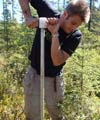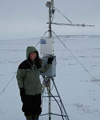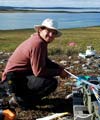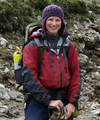Content Advisors

Dr. Maja Krzic
Faculty of Land and Food Systems / Faculty of Forestry,
University of British Columbia, Vancouver BC
How did you get interested in soil science?
Soil science was the first discipline during my undergraduate studies that allowed me to integrate basic science principles and to apply them to a real life issues such as food production and environmental protection. I was captivated by the unique nature of soils and the fact that there are so many things that we can learn and explore about soils.
Why do you think it is important to study soil?
So much of our life depends on soil and yet this natural resource, with which we are in direct contact throughout our lives, is almost completely overlooked and taken for granted. As a result, soils around the world are degraded at an alarming rate. It is essential that not just us soil scientists and natural resource managers but general public as well are aware of importance of soil and its conservation.
What do you like most about your work?
I love to work with students and to be able to tell them about exciting things that go on in soil and why it is important to preserve this important natural resource.
Do you have a favourite soil?
I certainly do. It is Black Chernozem, because it represents the pinnacle of all soils in terms of productivity, quality and beauty.

Dr. Nathan Basiliko
Department of Geography
University of Toronto Mississauga
What is it like to be a researcher?
Being a researcher is very exciting and rewarding. I get to choose what research projects I embark on, which colleagues I work with, where I conduct my research, which graduate students I supervise, and the balance between field (outdoor time) and lab (indoor time) work. I really do end up loving almost every aspect of my work… often to the point that it no longer feels like work! Part of my job is to provide effective training and inspiration for students. I am absolutely convinced that the largest impact of my work will come out in the students who will go on to far surpass my intellect and abilities and really have a meaningful impact in the world.
What are you trying to find out?
My research group is focussed on the communities of soil microbes in forests and wetlands that fundamentally underlie ecosystem function and resilience through the cycling of nutrients and carbon. We aim to determine how environmental changes (e.g. through forestry or climate change) impact the functioning of these soil microbial communities and in turn what consequences this has for the sustainability of the ecosystem at large.
How did you get interested in soil science?
I grew up on a small family farm and my father was always very academic and meticulous about the soil management challenges he faced, including reading soil science textbooks to figure out drainage and nutrient management issues.
How did you get started in science?
I was in a 2nd year Applied Ecology course at Cornell University as an undergraduate and the very engaging Professor Joe Yavitt often referred to undergraduates working in his lab on different projects during his lectures. I approached him about a work-study position and the rest was history! We published 3 papers together out of work I did as an undergraduate in his lab and 15 years later are still actively collaborating on research projects. At some level, I think I owe my entire career to him.

Dr. Angela Bedard-Haughn
Department of Soil Science,
University of Saskatchewan, Saskatoon, SK
Why do you think it is important to study soil?
Many of the most pressing environmental and social issues we face today will need effective soil management to resolve them: climate change, global food shortages, lack of quality drinking water, human health (toxicology), etc. Soil is more than just a medium for plant growth – it is the ultimate interface between the atmosphere, biosphere, hydrosphere, and lithosphere.
What is your favourite memory of working with soil?
Whoa, I have so many great memories of working with soil! But, if I were to pick just one, it would have to be up in the barrenlands of the Northwest Territories. I was in the field with my Ph.D. student, an undergraduate field assistant and a couple of other professors when we came across these mud boils. Have you ever done that experiment with cornstarch and water, where it seems to be both a solid and a liquid (i.e., a suspension)? That’s what these soils were like. You could dig out chunks with a shovel, but if you set your hand on the surface, it would just sink right in. I just remember all of us crouched around these mudboils, giggling like children while we played with the soil.
Do you have a favourite soil?
I’ve never met a Gleysol I didn’t like. Gleysols, and gleyed soils in general, have evidence of prolonged saturation. From bright blue Gleyed Turbic Cryosols on the High Arctic Tundra to thick Humic Luvic Gleysols in the middle of a farmer’s field in central Saskatchewan, I love them all.

Dr. Elyn Humphreys
Department of Geography & Environmental Studies,
Carleton University
How is soil science a part of your job?
Soil science is fundamental to my research on land-atmosphere interactions that influence local and global climate. To understand how energy, water and carbon moves through ecosystems and is exchanged with the atmosphere, I need to understand how these entities are transported through soil and stored in soil.
How did you get interested in soil science?
As an undergrad, I was hired as a summer research assistant at the Canadian Forest Service in Sault Ste Marie, ON to study how site preparation techniques affected tree seedling survival and growth in the boreal forest. I spent much of the summer installing sensors to measure soil moisture and soil temperature. It was fascinating to see how heat and water moved through soil and how little changes to the surface could affect these flows. I also learned to love a nice (rock-free) soil pit!
Do you have a favourite soil?
Humo-Ferric Podzol. This was the soil I spent a lot of time digging up during my graduate research on Vancouver Island. It’s distinctive and colourful and will always remind me of the fun I had as a young researcher.

Dr. Gordon Price
Innovative Waste Management Research Chair
Nova Scotia Agricultural College
University of Saskatchewan, Saskatoon, SK
What are you trying to find out?
My research is quite varied but fundamentally I study organic matter decomposition and the fate of chemicals in the environment. I am interested in the transformations impacting anthropogenic chemicals in soil, as nutrients or as contaminants.
What is the most exciting thing about your job?
The benefits of being a researcher are being able to continue to learn and explore new areas on a daily basis. The excitement of learning or accomplishing something new is part of what makes this the best job.
How did you get interested in soil science?
My interest in soil science originated from a desire to explore the inter-relationships between complex biological systems. This was formed out of an interest in agroforestry systems and grew into a desire to further understand the interactions that occur below the surface.

Dr. Paul Hazlett
Forest Soils Scientist
Natural Resources Canada – Canadian Forest Service
Great Lakes Forestry Centre, Sault Ste. Marie, Ontario
How did you get interested in soil science?
One of my first jobs as a high school student was working at the Cataraqui Cemetery in Kingston, Ontario. As morbid as it may sound, digging graves provided a great introduction to digging soil pits and getting an up close view of soil profiles. The 40 ha of terrain in Cataraqui was extremely varied in terms of topography and soil type and the cemetery manager did not believe in modern machinery so everything was dug by hand! In first year university I had a dynamic professor named Ken Rutherford for Introduction to Soil Science. He wore a white lab coat and had pure white hair, very much the mad scientist look, and he engaged the class by pitching Leda clay samples up several rows in the lecture theatre. I was hooked!
What do you like most about your work?
The people. People that work with soils, and in my case with forest soils are passionate about their work and their enthusiasm is contagious. Soils are such a critical component of ecosystems that individuals that work in this field understand that their efforts make the world a better place to live. That makes a job really rewarding!
Do you have a favourite soil?
Podzols are my favourite. I love the colour development in Bhf and Bf horizons and the variety of forest types that grow in these soils.

Dr. Tara Sackett
Post-doctoral Researcher
University of Toronto
Why do you think it is important to study soil?
Without healthy soils, many ecosystems wouldn’t function. Soils provide trees and plants with a physical structure to grow from, and are a reservoir for water and nutrients. Equally importantly, soils contain millions of living organisms that function to decompose all the organic matter from dead plants and animals, and recycle nutrients to be available for living organisms.
Why do you like soil bugs?!
Soil bugs (or invertebrates) include an incredible variety of different animals – there are thousands of species that look very different from each other, and do different things. Some of my favourites include springtails — invertebrates with tail-like appendages that they use as a lever to propel them into the air to escape predators. Earthworms are also very interesting – some species live in burrows that are more than a metre deep, and they pop out at night to grab leaf litter to bring back into their burrow as food.
Is soil a part of your childhood memories?
I remember spending a part of summer weekends weeding the garden. I loved the smell of the soil when we pulled out weeds or vegetables. Apparently as a younger child my mother found me eating soil insects as well.

Dr. Maxime Paré
Agrologist and Special Project Coordonator
PleineTerre Agronome Conseil, Napierville, Québec
How is soil science a part of your job?
Soil is almost everything – it supports life, contributes to our survival, and sustains our food supply chain. Almost all agronomy problems, which I face every day at work, have a soil component to them.
How did you come to love soils?
When I first began to study biology, I quickly came to realize how important soils are in all ecosystems and was shocked to see how poorly understood they were. Furthermore, growing up in rural areas around Montréal, I quickly came to realize the challenges that urban development poses for soil conservation (shopping malls, condominiums, etc.). If no one studies them, how can we know what we have to lose?
Do you have a favourite soil?
Soil scientists in the West would say Podzols while colleagues from the East might say Chernozems. However, I am more like a mother with her child, I like all of them!

Graham Gilbert
Former Master’s Student
University of Oslo, University Center on Svalbard, Carleton University (Previously)
What are you trying to find out?
My current research interests are centered on determining the permafrost and ground ice characteristics of quaternary sediments in Advent Valley (Svalbard, Norway). This research involves the analysis of many different physical and thermal parameters which will be obtained from a 70 meter permafrost core. Obtaining samples from frozen sediments is technically difficult due to the addition of heat during the drilling process. For investigation into ground ice characteristics it is important that the samples remain close to the actual ground temperature due to the presence of solutes in soil water and their influence on freezing temperature and physical state.
How did you become interested in how the earth works?
While my personal fascination with earth processes began as a young boy observing and interacting with nature my investigative interest developed during summers spent as a field assistant working in the Mackenzie Delta (Northwest Territories, Canada). Here I was able to participate in a number of field studies in hydrology and geocryology.
What do you like most about your work?
One of the most important aspects of working in permafrost environments is that it allows me to combine my research interests with my hobbies and passion for outdoor activities. Working and living in arctic regions presents many opportunities for hiking, skiing, and fishing. Often, going to work requires a snowmobile, boat, or helicopter!

Dru Yates
Former MSc Student
Faculty of Land and Food Systems
University of British Columbia, Vancouver, BC
Content Developers

Lesley Dampier
Former Research Technician, UBC
and Program Manager, SYLVIS Environmental
What is your favourite memory of working with soil?
I had an opportunity to do my Masters research on Yukon soils. My research sites were all very remote so we were dropped off by a helicopter, picked up a few days later, and moved to the next site. I loved having the opportunity be in a part of the world that so few people had seen. We used the evidence that we collected from the soil to help refine our understanding of past climates in the area. This gave me a new appreciation for soil as a recorder of history.
What did you like to do when you were a kid?
I have always loved the outdoors – camping, hiking, canoeing, and digging holes in the ground! My interest in the natural world led me to a geography degree. From there, the jump to soil science just made sense as soil in the basis of all that grows and lives on the planet.
Do you have a favourite soil?
Cryosols! These are soils that contain permafrost. The active layer is the layer of soil that thaws during the warm season and refreezes when temperatures drop. Soil materials in this layer are mixed together and create fascinating swirls and shapes. The permanently frozen layers also hold mysteries from centuries past which can help scientists learn about past climates and events.

Saeed Dyanatkar
Executive Producer
UBC Studios
University of British Columbia
Communicating science is Saeed’s passion and transmedia storytelling is how he does it. Saeed is a Media Producer at UBC’s digital media technology with a diverse background in engineering, photography, film-making and information technology. He has co-founded the newindows.org, an initiative to promote media literacy. He is also the associate publisher of The Source/La Source newspaper (thelasource.com).

Chris Crowley
Instructional Designer/Project Manager
Centre for Teaching, Learning and Technology
University of British Columbia
What kind of work do you do?
As an Instructional Designer, I work with subject matter experts, usually faculty and/or staff, to create web-based courses or online learning resources that use a variety of appropriate technologies to support teaching and learning and to encourage learners to continue their studies in soil science.
Is soil a part of your childhood memories?
I grew up on a dairy farm and I remember many days spent steering an old Massey Harris tractor pulling a three-bottom plough through crop stubble or pasture and trying to stay warm against the November cold.
Do you have a favourite soil?
Otonabee loam

Rachel Strivelli
Faculty of Land and Food Systems
University of British Columbia

Julie Wilson
Soil 4 Youth Project Coordinator
Faculty of Land and Food Systems
University of British Columbia
How did you get started in science?
I completed my Bachelor’s degree in Environmental Science where I learned about the fundamental structure and function of ecosystems. This is where I first learned the role of soil in the health of ecosystems. In my Master’s program at UBC’s Resource Management and Environmental Studies department, I studied the health of freshwater aquatic ecosystems. Through my research I discovered that different land use practices, particularly soil management, have distinct and important effects on water quality. Soil is the link between terrestrial and aquatic ecosystems.
Why do you think it is important to study soil?
I think it is extremely important to study soil given the current challenges we have to provide a growing population with food and clean water supplies. Healthy, well-functioning soils are key to providing these necessities not only to humans, but to all terrestrial (and many aquatic) organisms.
Why do you like soil bugs?!
I like soil bugs (particularly microorganisms) because they are mother nature’s filter system. Soil bugs consume toxic compounds and excess nutrients that are applied the land and thus provide clean water to drink. Soil bugs also convert nutrients from mineral forms into forms available to plants so they can grow and reproduce.

Afshin Sabouki
Graphic Designer (Cartoonist)